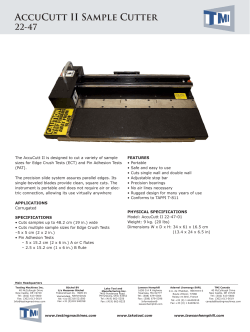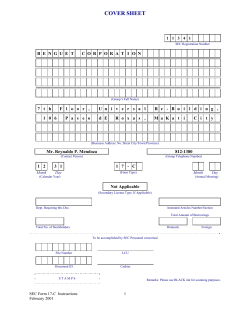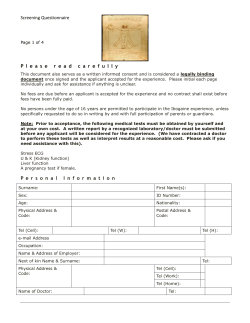
Document 276539
-
~
PEHIMENTEH
~, __V_O__'U_M~E~X~X~V~I~N~O~.~3~~~~~~~==~==A=U~G~U~ST~.__'9_S_'__~~
~
COPf.ig ht, 19 5 1. Ge no".r Roc/io (o ,"p<ln .,., Ga mIN-idgo, Mo u., U. S. A. .
on•
z:
=
I-
""
e..>
-'
""-
""
""
-'
""
lV>
::0
=
Z
...""
:x:
I-
=
Z
""
on
...
...""
...::e""
A SAMPLE HOLDER
FOR SOLID DielECTRIC MATERIALS
eA KNOWLEDGE of the <.licJC(:lric propen icsuf inslllllling llIaterials i~ impon ant..not
only to t he rlt'~i~I H'r who utilizes such maI N THI S I SS UE
tcrials fur insulation stntt' l urCli hut nlso t o
Pltg,
the physicist lIllO (,hemi ... t who is concerned
\rill' HllF-OST.l.T llt,' u:-;with Ill!' intcm aJ "trw'lure uf the mntcriai.
otT,; ?
FE'om either point of vicw. it is impOl'tlUl L
10 he able to make mea.s urements oyer 1~
wide mngc of frcqucl1(,jps. If t he ma terial is to be \I ~c;J as in:;u[(\t ion, it.
i~ ob viously desira ble \0 ohtai n d a ta at til(' fl'f'quency of lIi'C, while. if
Ih{' fundame n tal Slntl'turc of t he mllterial ili of imcrc.;;t. the va riations
of dielectric consta nt lind loss factor wi th ft'C<llIellcy at'(' d ue!'i to t he
clwtni("ai stt'llctUt'("
1n the accepted method of cndua ting t he die1C{.'tri(' ('on8tUllt and
di:s;:i palion factol', a capacitor is formed b," pllll'i ng the material bet.w('('n tnf'tl1ll i(' t'll'clrodes. If ihe cunfigUt'alion (Jf the eleclrodes is such
lhal lhe distl'ibutiun of t he electric field is a.ccurately k nown, t he
IZ
::e
::0
V>
-'
-
""
e..>
......""
l-
e..>
Und e r the rece nt Order M·7 1 of the Na tional Pro d ucti on A uthor ity,
a ss ista nce is pro vide d to tec hni cal and sc ie ntific laborato ri es fo r th e
pr oc ure m e nt of need e d s uppli es and mate rial s .
In a cc ordonce w ith the order, a laboratory m a y a ppl y a new rati ng,
DO-Xl , 10 obtain d e li ve ry of products and material s need e d to carryo n
s cie ntifi c or tec hnol o gi cal investigation s, testing or d evelo pme nt o r
ex pe rim e ntation, pro v id e d thai Ih e total amount e x pe nd e d does nat
exceed $3,000 during anyone quarte r.
No furth e r a u thori zation is needed from Ihe Noti o nal Pr o du ction
A utho rity 10 use th is rating , but all prospective use n s hould c o n s ult the
NP A Orde r M_7 1, wh ich may be obtained from th e ne ares t fl e ld office
o f the De partme nt of Commerce, before appl ying the rating , a s ils use
is necessa ril y re stricte d .
The ord e r als o pro vi d es a mean s far la borato rie s to obtai n ce rtai n
am o un h of c ontr o ll e d mate rials unde r the Controlle d Mol erial s Plan.
-'
IET LABS, Inc in the GenRad tradition
534 Main Street, Westbury, NY 11590
www.ietlabs.com
TEL: (516) 334-5959 • (800) 899-8438 • FAX: (516) 334-5988
G ENERAl
RADI O
,
E X PERIMENTER
~'UllStU.ll{.S
of the material \':U1 bc df'termined from the clCCLrie!ll mcasUI'Cment.'!. Among lllnu; lures rcauil.v ('ulI'lilahle are parallel plates and concentric
l'yHnderi::. At power, audio, a nd radio
frcqucncit"S to 100 mcglLcyc.\CS and morc,
parullf'l plates alT' used whenever pOl+.sible beeause of the rcialil'C elise of
preparing a spol'iml'll, I n a two-f'lcctrorlt'
plane system, a circu lllr cled,rodo ilj
most widely IIsed because the fiel d cullfigul'lltioll is symmclrieal nllli most
renuily ealcnlated.
At frequencies in I he megllcyde I'UIl~C,
the induc1ance and resistance of lends
cunnetting the electrode system to the
measuring circuit can introduce error
and must be considered. III a classical
paper, H art.shorn and Wurd* described a
method of essentially eliminat ing tead
impedance by combining thc measuri ng
capacit.or a nd the electrode system and
using Ii substitution method of measm (lment, This type of holder is generally
ret;ognized as the most satisfa(Jtory fo r
measurements at radio frequencies, It is
recognized in ASTM Spe(.'ificntion 0 -150
for use in the frequency 1'ange from 0.1
:\1c to 100 Me.
01.. lI&mhOl'a .. ,,,I 1-1 W"..-1. I',""-.d'n .... . 1 €.~; (I.on,1<>11). V,,1, 79, po.l[fII (;97 1<> 609
The THE 1()90·}\ Di('lectri(' ~amplt'
Iioidcr, showll in Figure I , is a miel'ometer·type holder of t he H a rtshOrl1 InK'
with 8e1'C1'al importa nt I'efillclllents ill
design.
DESIGN DESCRIPTIO N
A tl'otiti-scet io n view of the s!lmpl('
holdel' is shown iu F igure 2. T he 1111;I.il1
micrometer cupacilo1' is formed by t h!·
two eleclrodes (H ) a nd (l.o). T he surfaces
of t hese electrodes a re opt icall.y grou nd
to be plane wi thin Ii. few wHvelenglhs.
A precision-ground micrometer screw
drives t he movable grou uded elccu'odc
with respeut to t he fi xed insulated
elcctrode. The screw adjustm en t is a.
{'oovenienlrsizc instrumenlrtype knob,
in contrast to t he small t himble employed in t he usual machinist 's mi·
crometer commonly employed for t his
purpose. The s pacing of t he electrodes
is iodicated by the la rge legible calibra.tion on t he drum as sho wn in l"igure I.
T he smallest division is onc-ha lf mil,
with 1/ lOth mil easily readable, The
micrometer screw is elect rically shunted
by a Rexible copper bellows to assure
low a od constant resist a nce aod io·
d uctanee in the current path t o t he
movable electrode, 'fhe lower elect rode
is supported in posit ion by Vycor in·
s ulators whi ch l\fe well aWll,V from the
field bet wC{:n t he electl'Odes.
A unique fea t ure of t he design is the
method of d riving t he movable electrode,
A s pring-loaded d rive is I\sed so ar·
ra oged t hat, when the movable electrode
comes into full contact, with t he specimen (or thc bottom electrode), t hcd rive
disengages. T wo im portant, resu lts arc
achieved by t his design fea t ure: ( I) t h('
movable electrode assumes the pl :~llc of
the lop surface of t he specimen, t hus
fig ur .. 1. Vlaw of the Type 1690· "
Die1 ectric So mple Holder.
IET LABS, Inc in the GenRad tradition
534 Main Street, Westbury, NY 11590
www.ietlabs.com
TEL: (516) 334-5959 • (800) 899-8438 • FAX: (516) 334-5988
,
AUGUST ,
assuring best possible contact even if
the faces of the specimen arc Tlot rigorously parallel, and (2) straining of the
micrometer screw is avoided s.i nce the
drive dir;aengtlgc;o :-II :l. predctf'rmincd
PI'($."II/'('.
A VNlliet' c'ap:w i! elr \\'it h a (·1~p:J.(li ' alice
runge of 1) J.l.J.l.f is also provided , fol' use
in oetermining the widt h of resonance
curves ill the susceptance \'llrialion
method. T his capacitor is of t he cylindri('(LI lype, lhe movable cyli nder bripg
:l. pr~)ision micrometer scrgw. Ten turns
of t he 8crew covel' the range of 5 IlJ.lf,
and the drum attached to Ihe screw is
ac{) ura~el y di \'ided into 50 d i vi.o.ioIlS, f'lwll
("orrcsponding to 0 .0 I J.l.J.l.L
Facili ties fo r connccti ng to the \·1ect 1'00Ies
and f')I' mOlluliug the holder arc
extremely Aexible. Pin-tn)(' l'on nCl'tors
011 standlJ.l'(l U" spacing may ue usoo,
0 1' j'omptetely shielded conncction:! ma,"
uc made wilh TYI>E 874 Uni vc!'Sal
l 'oaxiat ConnettoJ'S, ' ('erminal fllCitit.ies
tllld mounting bosses are provided both
at bott.om a nd si de of the housi ng. This
l>Crlnits t he holder to be mou nted with
! he elpctrodes horizontal whether the
l1:.l nel of t.he bridge or olllc.' mctl.'J llring
('i l'cuil is horizontal 01' v('l'tir'al.
The cloot,rodf' as."Cmbly i~ mou n ted
ill JJ !'uggPfI a luminum ('usting. which
:-:h it'ldil ! h(' as.'wm bly on four' sides . The
~ hic.--ldiTlg· i~ ('ompll'\4'd l1y t,II'O a lumin um
19.51
side pa nels which cun bcswtlrlg Ollt. of l he
way to insert a nd remove t he s pccil1lf'n .
lOW·FREQUENCY
CONSIDERATIONS
Altlwllgh the mi crometer type or
holdl'!' WliS uriginally "o/lcei\"cd fOl' liS{!
itt frf:~uell c i es fl"Om 1 to 100 M e, t he
T\'P~~ 1690·A was designed ill t he eon·
\'iCI iou t hat it will be as useful at audio
a nd power frf'qllenr'ies :l.S at radio frequencies, The use of this type of holdCl',
pl"Operl y calibrated , virtually eli minate!'
the errors fro m edge capacitance lwd
stmy cnpU(Ji tSlIlC"C withou t r~orL 1.0 til('
complication of guul"Cied specimens ~1H1
mCll.f:uring circuir..,>. The validit,y of this
"rall'm!..",t i8 clemonslrnled by the fol lowing t)t11 Iin(> !of t he Illf'thod s of cali b ration
a ll d
U!{! '.
The tutw (':qmt'itu nct' Itt, the Lerlni·
mlls for :lIly ilpaci ng I elf the ,,1!;leU'od es
can be considered !l.S t hp Hlim of ,h('
fOlle)lI'illg !'ompollcnt..'>;
( '" - the direct geomeu '[c capllcittlZl('C
bet ween the electrodes,
r~ lh c fringing eapacitll l1ce, e,1"
<lPdge" !'u ]llll'it a lwCl, rontriburrd
by the lilles of fo rce pns.-.;illg IIi·
rc('lIy fl'om c\(wll'oLir 10 ('1('('tmdt'
but outsidc t he edges.
r'~ ,ltf' sl r'a." ,'apacita l1l"i' of !hll in·
sul utcd ('Icdrode lwd lend to tl ,, '
gl'ollndC'd endu:m!'{'.
Fi llur. 2. Cross section of It.., el i_
e teclf"tc samp le hold"r show;1\1I
delails af «><l" n,,,Ii,,,, ,
"
(lNSULATEO tLECTIlOOE t
V 1.. ,ello .. tl[1I
IET LABS, Inc in the GenRad tradition
534 Main Street, Westbury, NY 11590
www.ietlabs.com
TEL: (516) 334-5959 • (800) 899-8438 • FAX: (516) 334-5988
OUURAl
RADIO
•
EX 'ERIMENltR
('", -
an l·J'I'OI' I:omponent caused by a ny
ml'4'hanical impel'fecLions in the
Sel'!!\\' thread and by any slight lack
of pamllf'lism of the elcdl'odes.
The diifl'rr1]cl' in l'uplI,cihmce l>etwet!n
:1'1.\' two sf'l1i'IJ.,"l'! II lind '-! is then the
SH ill of the dilTcn'ilcl'S of t be individual
,·,lInponcot,.,
t::.('= t::.CD + 6 (\+ 6 ('~+ 6('...
The direct cnpncit ance ('" ('UII be cal"u lated !\(.'(·umtely fOI' i\lly i'eLting, but
Ihe error terms cannot. Thf> calibration
is made by meMul'ing the :leilial 6(',
laking arbitrarily a spacing of [00 mils
:1.8 t he reference point, The differences
hNWCI'Jl lhe obscJ'ved t::.C and t he 4':l11'lIla1NJ t::.C" are plotlt.'d in the fo rm of
:~ ralihratioll curvf' M shown in Figllr(' 3.
From l l li~ CILI'Vf' the di fference in ('I'ror
lCJ'm!l h(>!.w(:cl1 any two :o'\el1ings. ('llll hI'
del erJll ilwd .
In Ihe nOl'II1:11 method of (l$I', all "h!l('1"vatiuu !If the measuring circuit is
IIHl.(je with the s;lmple in place, at, n
selling II' The lotal eapaeitanc(' i~ tlll'll
('r+C,'1+( 'vl +("~I
Witl, I he samplf' remuved, the elttlr04.11'
:;plwinl( j,; 1'I'dlll'('11 1Inlillhl' totaI4'ap:u'ita lWf' i..., "t'ston'!! to ils origin!!1 \':dUf',
whi{'h lli('1l ('1111 hI' f')l.prw..'lf't! ft.'::
( '~ ~ + (',2 + ('u~ + (' .. ~
I~qll:iling
lIi(' two ('xp!'cs,<;ionF., Wf' haw,
L'r = (',,'! +L t::.('w""
Rut thc summation uf the ditff'l'l'lU'eR
in th(' cn'Of' t("'ms is precisely 11ll'
qLulIltity given in the {,:llibrMioll l'urvc
of I"igllrc :l. Tlwreftwe til e ('apaeiianec
I-
"
<
::;
w
~
~
'.0 I-2.8
f-
~
2.6
c
o
I£fftl~
FREOUENCY
Fillure 4 . Di.l.d,i<: cOI1.lanl and di .. ipa llon lacla,
af ....... pl.... f poly~lnyl buly,al 'IS .. ,a ..".d
...1111 III. Typ. J690·A Oi.l.d.ie Sample H.. lder,
.... Typ. 7 16·C C"p .. clt .. n,. B,idg., .. nd the
Typ~ 82J·A 1... in·T Imp.dance_Measuring "' ,, ' _
wa .~ .
of the s:un ple is the air ("llpaeittllH't> :It
the scttillg l2 after cOI'J'l'Clioll from I hI'
calibration data. Fo,' cOllvf'llimH"l', t:lblcR
of t he calculaled fl.ir ca.pacila,J('e for '2"
clCl'lrode:-l are pro\'idf'd.
TIlt' on ly:1.: IImptioll il1vol\,('(1 in this
lllf'lhvd iti tha I Ihe fring ing ('upilt'itlllH:C
al Ih(' ":('1ting II i,.: Ill(' salll(' n'g:u·dll,........
of \h,' di('lpdl'w COllstan! ()f til{' IIwdiul1\
hf'lw(>('n tilt' platt''':. Wllill ' IIl is i.... Ilul
"i!{ol'ollf->ly (nit" tlw ('l"rfl l' i n \'oln·d :q)p<'al'l'l t t) be \'f' r ,V ",mall.
If !I, .. >;JX'4'imcll i:'l smIllieI' in dialll('lf'l'
th:.n tht, elP"II'QtJ4':'I, l hr' t'xpl"f'ssioll 1'01'
its cupueit:1IlI'(' i.-;
Cz =
('~2 - (",)
(1 -:::) +
('4\1'1'1:\ '1
ion!;.
where Az is the are:! of til(' :'IlI mpll', . , ~
the urea of t he electrodes (3.1 -1 sqU:I1'1;'
incheR fOI' 2" elecu-odNl).
MEA S UREMENT S
Figu re 4 shows typical mell};UI'I' IIH'llt:'l
made with the new holdel' over tlll~
. 0.2
•
0
;~
z _04
~
-Q.6
~
_,0
figure 3. Typical calib ra rlan (urv. for rh e
Type J690·A Oi.l.cl, ic Sampl . Hald."
"... -Q.8
-0
IET LABS, Inc in the GenRad tradition
534 Main Street, Westbury, NY 11590
www.ietlabs.com
TEL: (516) 334-5959 • (800) 899-8438 • FAX: (516) 334-5988
IET LABS, Inc in the GenRad tradition
534 Main Street, Westbury, NY 11590
www.ietlabs.com
TEL: (516) 334-5959 • (800) 899-8438 • FAX: (516) 334-5988
GENERAl
RADIO
•
EXPERIMENTER
WHY RHEO STAT BURNOUTS?
Because of the mlture of the cil'cuits
in which rheostats a re genera.lly employed, thf' cunent Uwough the I'heostat,
1l,,\U1I.U,V varies in a directioll inverse
to the amount of resistance inserted in
the ci rcuit, Oftentimes this fact is o\'erlooked when choosing a wire-wound
..J)oostat for lise ill a certai n circuit
position, The result may be that. 1.00
i'lmall a rheostat is used and that the
]cx)alized overload, when small values
of resislance m'e ill circuit, either bums
out the rheostat in short ordel' or, if it
does not burn the rheostat out, gmduulIy l'mbrittles the phenolic mandrel until
il brf'ak!;l. F.ithcr condition, unf\wtunat.eservicc.
I.", takes the rheo:;tat oul
Probably thcre are othel" reit.<Jons I han
ovefi!:ight for using too small a rht.'()slat.
TIlf' Apedtier of componentil mlly l'onfusc
Ihe i)chavior of lhe usual low-opel'l.uingtemperature wirc--wound rheoslicts with
that, of t.he ones espcf.:iltlly designed for
high-power uSt") , Many of these lat.ter
have insul(l.led aluminum or other met.al
fLit a mandrel ; many, in addition. hn.v£'
or
all aluminum IHlllsing, The nutal t£'uus
10 ('onduct llw heut tlW\i.y from t he
I*'('lion 1U't.u:llly ('iu'j'ying tIl(' CtuTCllt.
pl"vducing [I. So-I.'allt·d " cnd c-fT(.'i" ·' wh iC'1l
is quill' hirge, The :t1l1011UI of energy
1hnt ('all Ill' di&~ip!ll(·d ill u V"C'.\' :;mall
pl'Oportion of the dj(.l(~ tat is only
f;l ightly j'(<{lueed r.'fIm the o V('I'-all {'Ilf'I"KY
ncting of the rheostat wlll'1l all the
reRistance is in.
The gcncrally encounlcred 100v-operating-temperat.ure wire-wound rheoRtat has insulat.ing part-s mude f!"Om
phenolic materials, paper-based 01'
cotton-cloth-b!U!ed for the lamioaled
materials, and wood-ftour-hased for t he
molded materials, '1'he longitudinal COIIfhu:tivity of these phenoliC": materials
away from a slDall area in wh ich 111('
encrgy is being dissipatt.-'d i;; vcry small
com pmed to the conductivity of metals.
l-IolI'c\'el", it is.n't completely negligiblt"
There is a sillall "end eITed."
Advantage may be taken of this " end
effect," if it is done with care, 10 en:l.blf'
one to use It somewhat s maller rheostat
than he might. othenl' ise use in Cf\.8eA
whel"e the circuit current goes up tI.S
rheostat resistance goes dowlJ with shafl
I'ottdioll . Measurements have bccn rnade
on one of OUl' T n'E 214 Hheostat.s to
diS(!ovc-l' the magniludl' of the " end
t'fTcet," 'rhOS(' rheostat.'! huve rated
CUrl"t'nt~ which will pn)Cluc'c' u ()(1° C ,
rise at the hut spot. l! II'U;; found, for
in:'llancf', that if ulll.v oc)c per CCIII uf
lite resiiilHtll'e uf a lint'al" rheostat Wa~
in ('ircu it. it{'u(cld C'MfY 111'0 tim!'" raiN
{'''ITem without exceeding the allo\\":~bl e
1.;0°('. I';:"C, Thiil n,nd uther tigul"(:~ fUl'
lurger I"Qtatic)I1 percentagt's fire ginon
III t IU' tilhlt',
('''(,f rll/
t I'~
"~
~uf
to C'~
:'-'0 1:
{J(j> ('. niNc
1. 1 X mted rUfN'1l!
1.03 X r"ted
c urr(!n~
I t will 1)1' nllt ('(I th aI , he allo\\llbl,·
ilC l'l"l'/\:iC in C1I1Tt'nt. mlillg!tt 101)('1' cent,
I'olutiorc is cN;f'llIially Ilf'gligible. Evf'1C
that at 10 per ('cnt. J"ut3tion is IIO~ \'Pry
significant.
The information in the table has been
ploLted up in two ways and di'iplayed
ill Figure I. The variation of allowable
current with percentage rotation if'.
sholVll on the lower curve. T he upper
curve shows the amount of energy whii'h
can a.ctually be dissipated (/2R ) as a
function of rotation. If there were nQ
"end effect," this latter cu rve would
folio\\' the course of the dot,ted 45°
IET LABS, Inc in the GenRad tradition
534 Main Street, Westbury, NY 11590
/vr
2 x rnted curren!.
1.6:', X mt.ed curn~ ll\.
1.3 X mtt..>d current
www.ietlabs.com
TEL: (516) 334-5959 • (800) 899-8438 • FAX: (516) 334-5988
,
AUGUST ,
tim:. The dcpal'tur'cs above the .15 0 line
al'e tho bc.nf'ficitl.l "(!Suits of the "cnd
clit'Ct. .,
:O;om(" diSi.,t'ct ion should be t'xcn:iscti
ill maki ng liS(' of t hese figmcs. I L shou ld
he n~mcmbel'ed that. t hey represent data
adllully taken on a particular design of
rhcObtllL Cil/\ngc of geometric proportions, materials, and so on lI"ill change
the value!; of the clIn"Cllt-mu lti piying
fru:HlI's fot, smull rotiltiOlls. Change ill
rcsistu llcc vu lue should have negligible
effect. The rcal criterion should, of
course, be
II
direct
!lllci
not a deri ved
'Ul('. If olle wishes to get. all QIIO possibly
cau ullI of a rheostat , he should do
it by lIclwdiy mC:1SlJril\~ the tf'mpcr:1r
lul'f' rise uncleI' his OW II pl'Oposcd current.
conditions to be SIII'C th:lt 1he safe
operating temperature of the unit isn't,
{'xcecded tinder /lily conditions. There
is no substitute as good as It tesL under
actual COllditiollR of use.
Of course there al"e ways to improve
t.hc cUI"rellL-carrying capacity of a rheolltaL at low rotation angles, but so far
this article has dealt wit h the llerformanee capabilit.ies of a stnndard Iincar
rheostat. One way t.o increase lowrOlation current-carrying capacity is to
wind thf> low end wit.h lowel' resistance
per unit. angle (larger wi re, lower I'e::;itltivity alloy. or hot.h). Another \\' I~Y
would be to include between the phenolic
Illlilldrel lind the winding one 01' t.wo
thin pieces of copper 01" Illuminum to
('onduct. the heat away from the 0\'01"-
TilE
t;erleral
ill
limli o
1951
~
l-
I-
-
I>0
,
f1~
,f:,,
,
$I
.,~
,
I>?
RAtIO
>0
'0
PUiCEN1" ROTAnoN
'"
fill"'. 1. Piol of tl. .. ollowabl .. oY"rlaod f .. el<>,
for Typ. 214 Ith eoslal" , .... llinll from the "end
"ff"cl" 01 ,m .. 11 an9'''' of rolalion.
iO/lded sectioJl. The conduct ing pieces
need not. necessarily he the full length
of the mandrel. Beyond the complica. .
tion of manufacture, t his expedient. does
not degrade the performa.nce of f,li('
rheostat. on d.e. However, it would
seriously limit the usefulness of lhe
rheostat ai audio frequcncies through
the cnpacitfltlCC which the metlll conducting piecc would introduce acrOss all
or part of the rheostat winding.
.It is hoped that this information may
be found useful in some marginal li p....
plit"Htionf! of rheostats, to enable one Lo
reduce lhe rheosta.t size without losing
t he ad vantages of specifyi ng a standard
rheostut normally carried in stock .
- P . 1\:. MeJ':uIOY
E-'i/'~UIMf.W""·:U t .. "wiled
wi thQu.t
1.: IHlrJ.!l' cfldl
11/0"'" to e" gineers, Scietl/jlS t.S, ' cd HliduI/s, ""d o ,II erlJ ill/ c r esflu l
co ml/,/lllit.YltirUl.-jr cfl" CII.CY I" CII S III·e IItClI. l fInd co nl.rol problc llt ....
Jrl h ell scnd i ll g ref/ucsts jor s ubscript.ion s (md adclress . . clwlIgc notices,
p lease SlllJply ,ltc jollowill g illjorll/atio//.: IIam c. co mpuIIY address, type
oj business cOlllpflny is c II glI gcd ill , lind. ti tle or positiOl/ oj individuu/,
IET LABS, Inc in the GenRad tradition
534 Main Street, Westbury, NY 11590
www.ietlabs.com
TEL: (516) 334-5959 • (800) 899-8438 • FAX: (516) 334-5988
GENERAl
RADIO
•
lXPER IMEN TER
Vi .. w 01 .lIe G .. nerol Rad io boatll at the 1950 Pacific Ele(!ranic hllibi ••
SEE US AT THE
PACIFIC ELECTRONICS EXHIBIT
B(' SUI"(, to see the Gcuerul Hadio
booth al the PlI('ific Electronic Exhibit ,
.\ut-,'llr;l :!2, :!:{. und 21, at the Civic Auditorium ;11 ~all Fran{'i>'(:o, Caliromia. In
hooth" 11 8 I~nd 119 the General Badio
('ompany will h:lxe on display a number
of n('w illslrumcnts, some of whic h havc
illl'f'udy been described in the Bxperitnl'n/er and others that wi\1 1)(> dcscrihed
in forthcoming issues. Among th(' ncw
instruments exhibited will 1)(' the following:
T\I'E 1021-A L'-II-F r-II-F
:-Handan:I...lSigllal (:f'n('nltor
'l'YI'E HiO'2-A I.:-II-F
.\dmiu:ul('c ~ ll' t('r
,]" I'E 1330-A Bridgf' (}scillntor
TYI'E 13!)()..A Handom
!\'oi* Genel'lltor
T'I'E 18(i:!-.\ .\ I<'!;"ulunnwter
T HE Hi,')2-A D-C l.imit Bridg{'
Tn'~; 15.)(}.A Octave-Balld
:\oi5(' Anllb'zer
Tn'.; 7 1-A rurinc· TrunsfOl111 er
'1', P.: 871 ( '(l:odal Elements
;..rew L'nit lnst rumcnts,
and standards of resistance,
capacitance. and inductance.
Thc Pacific Electronic Exhibit IS
sponsored by th(' West Coast Electronic
i\ lullufllcturer.;' A s..~i:lt ion and is held
jointly wilh the \rcstern Convenlion of
the Instit ute of Hndio Engineers. In
{'onjullctioll Ililh the Exhihil, two busiIless ('onfel'(-'l1('('5 will he held, one on
"Govel'lllDcnt. Procurement Pr()('oourc,"
\redncsday, August 22, and another 011
" Where the Electronic Indust.l'y Standli
in the National Pl'cp!l.l·edness Program,"
Thursday, August 23.
GENERAL RADIO
COMPANY
215 MASSACHUSETTS AVE N UE
CAMBRIDGE 19
MASSACHUSETTS
TELEPHONE; TRowbddl ' &·UOO
BRANCH ENGINEERING OFFICE S
N(W
'O~K
5. IIEfI lO.K
II WEST STHET
TEl. WOrib I · Slll
lOS AN6HES 11. CAlHORIIIA
IlaD NOnH SEWARO STREET
TEl. HOtt, . . . . ,·U&I
CHICAGO 5. ILLINOIS
Ht SOUTH MICHtGAN AVENUt
TEL WA .u~ 2 lUG
.,...
,
IET LABS, Inc in the GenRad tradition
534 Main Street, Westbury, NY 11590
www.ietlabs.com
TEL: (516) 334-5959 • (800) 899-8438 • FAX: (516) 334-5988
© Copyright 2025










